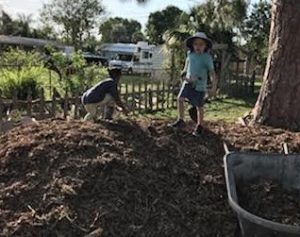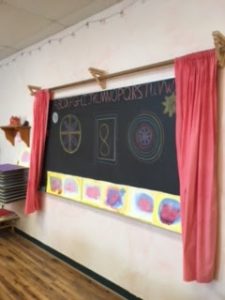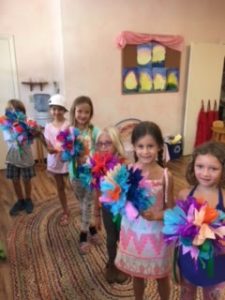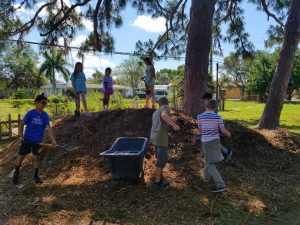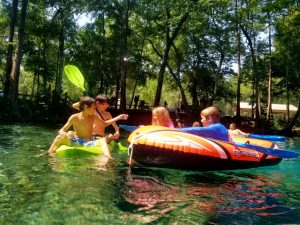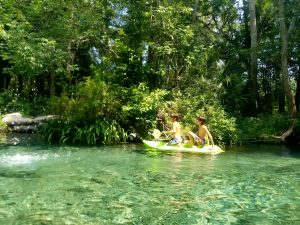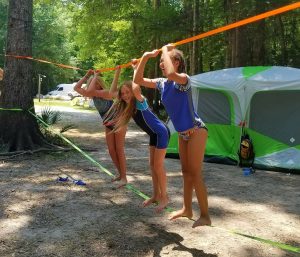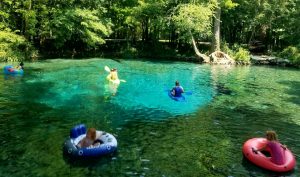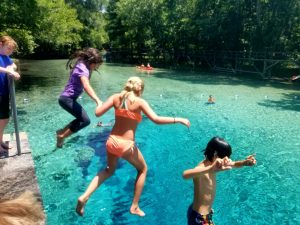If you truly love nature, you will find beauty everywhere. – Vincent Van Gogh
We have had so many nourishing nature experiences lately, such as our 5/6th grade camping trip to revel in the natural beauty of one of Florida’s many springs!
We are also so grateful for all of the beauty found right on our campus! We had so many volunteers and donors for our spring garden spruce up and potluck. Thank you to Ms Jessica, Natalie Maute and Keshara for organizing this event! Thank you to Michelle Roy, Kerri Loafman, Tracey Swenson, Rebecca Rothstein, Jon Stevens, Birte Hoag, Laura Barrett, Chris Maute, Heather Green, Chuck Green, Birdman, Darcy Banks for your presence and/or donation. Plus all of the students who came to help!!
Thank you to Troy’s Tropics, and Crowley Nursery for the many plant donations!
Our Giving Challenge and Rollathon was a huge success thanks to YOU!
Thank you so much to our sponsors: India Artisans, Michelle Roy, LMT, Kombucha 221 BC, Veronica Fish and Oyster, Saltmeadow School, Island Deoderant, Rodriguez Wealth Management, Keshara Alleyne, Marion Scott, and Birte Hoag!
Our deep gratitude to our donors:
Stephen Lallo
Linda Lallo
Stephanie Lallo
Erin Melia
Dawn Barca
Jeremy Thode
Kitten Linderman
Jessica Kramer
Angelo Chiroli
Dina Brantman
Erice Wilson
Dana Damico
Yolanda Benoit
LeeAnn Sanders
Thomas Melia
Marion Scott
Misty Tavenner
Diana Lennon
Suzanne McMillan
Vicki Bartnikowski
Denise Boccio
Bernard Stevens
Michael J Turillo Jr
Mark Caragiulo
Deborah Turillo
Alexey Logvinov
Laurie Duchamp
Laurie Duchamp
Ellina Logvinova
Karen Freggens
James Suter
Larisa Balykova
Heather Green
Sheri Hartnell
Laura Baumberger
Lisiane Jimenez
Arti /Karen Ross Kelso
Sarah Holton
Jon Stevens and Shivani Lash
Michelle Suter
Tiffany Hillary
Teresa Holton
Laura Barrett
Kerri Loafman
Jessica Rood
Billie & Ivan Miller
Nancy Albright
Jerry Fleming
Diana Huss
Brian Mackin
Maureen Burns
Fred Jones
Robin Maute
Danielle Duchamp
Kerry Cripps
Oden Torres
Timothy Williams
John Schroeder
Sheila Williams
Michelle Carroll
Nancy Heller
Ernest Pappanastos
Jessica Bromby
Francesco Bissaro
Tara Olesen
Joshua Hillary
Heather Green
Darcy Nelson
Aneta Lundquist
Cheryl Kindred
Kombucha221B.C.
Ming C. Lash
Mathilde Brock
Rebecca Jaeger
Michelle Roy
Cal & Sue Lundquist
Robert Kindred
Judith Lescano
Diana Kanoy
As well as several anonymous donors!
Thank you to our families who reached out and garnered contributions. A special thank you to Laurie Duchamp, who bequeathed the largest donation of the day, and to the Lallo family, who secured the most matched donations!
What a gorgeous Festival of May! Thank you to Gustav and Tatiana for providing the tunes, and for the many families who brought flowers. Special thank you to Eric and Aneta Lundquist for serving as runners for the event!

Upcoming Events:
Ongoing: Satchels’ Donation Drive by the 5/6th grade. Dog or cat food, as well as new or gently used pet supplies welcome. Please drop off donations in the office!
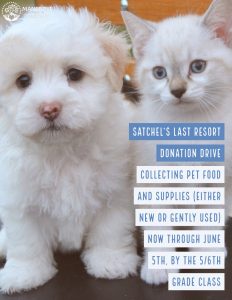
Join us for I love the Earth Nature Camp! J’aime la nature!
Hosted by Miss Jessica
Little Naturalist French Immersion Summer camp
Week 1 – June 11-15
Week 2 -June 18-22
Week 3 – June 25-29
At summer camp this year we will focus on nature and loving the earth, while learning about trees, birds, insects and plants.
We will care for the garden and connect with plants and growing our own food.
We will play games, create art , and make organic home made popsicles.
We will speak and learn french!
We will play in the water!
We will sing songs from around the world!
We will dance dances of universal peace!
Free play too!
This camp will take place outdoors and inside, from 9am-1pm.
Please pack: bathing suits, towels, water bottles, snacks, change of clothes, and a sun hat.
Jessica has been teaching kids camps for 20 years and is a nature trained instructor, leader of the dances of universal peace, song collector worldwide, peace maker, traveler, gardener, french teacher, and lover of nature.
Limited space available. The cost per week is $175. Drop in is possible with pre-registration, and is based on availability. Mangrove students of 18-19 are eligible for discount, please inquire.
Camp registration forms available here:
http://www.mangrovesarasota.com/i-love-the-earth…-jaime-la-nature
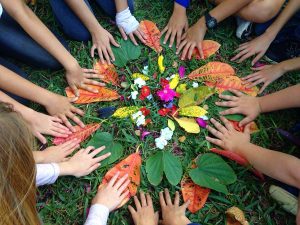
Merci beaucoup ! Thank you very much!
5/6th Grade Play – Julius Caesar, Tuesday May 29th, 8:45 am All are welcome to join!
Thursday, June 7th – Rose Ceremony for First graders/Spring Assembly/ Potluck/Early Dismissal 11:30
Friday, June 8th – Last day of School/Community Beach Trip – Meet at Siesta Key Beach at 8:30
From Our Classrooms:
Seahorse and Starfish
The last few months of school have been very busy for the Nursery and Kindergarten. The children have had two new circles. The first was about planting seeds and the children are little seeds that plant themselves in the ground and grow toward the light. The second part of this circle is a handkerchief that is put around the teachers hand and really looks like a rabbit. This rabbit has a song and the children are able to feed it carrots until it has had enough. The children learn a lot in this circle, such as waiting their turn to feed the rabbit and what it feels like to be a growing seed. They can feel empathy for growing plants and living things. The second circle is about going on a picnic and floating little leaf boats. It has a imaginative component that has the children imagine floating down a river on a leaf boat and finding a place to have a picnic. They learn to use their imagination in this way and when they start academics in 1st grade will be able to fully embrace the concepts of Math and language arts in a more comprehensive way due to the expanded awareness of the imagination.

Outside the children have been helping to water the new baby trees that have been planted and move the mulch pile to under the new swing set. Thank you to the 5/6 th grade, Ms. Erin, Bryan SUter and our woodworking teacher Mr. Eric. The children learn to be the stewards of the play garden and love to watch the trees grow and make sure they are taken care off. They learn that besides the earth it is good to take care of ones own needs too. The children have enjoyed shoveling the mulch into the wheel barrows and rolling it over to the swing set. They have learned how to work as a team and where it was the softest spot to shovel the mulch from the hill. This activity helps with their balance, gross motor, and eye hand coordination, as well as taking responsibility for a task well done.
Inside the children have been busy with sewing balls using 5 colors of their choice, cutting veggies( thank you to those who have been sending veggies), and painting with three colors. All three of these activities help with fine motor coordination, which translates into proper hand grip for holding a pencil and proper hand writing in the grades.
Our special projects have been growing wheat grass for the Spring holiday in baskets and the children have sewn little rabbits out of felt. They enjoyed watering the grass and were very excited when it started to sprout. Our Mother’s Day project was a hand print made out of homemade clay. We made the clay in class and they watched a teacher roll it out and made their hand print. They then picked the color tissue paper to wrap it in. The children especially liked playing with the extra clay. It was a different mix than the play doh, so had a different feel. The clay was fun and the children enjoyed using their fingers as well as their hands to make shapes, animals and objects. This strengthens their fingers and hands as well as promotes concentration on a task.
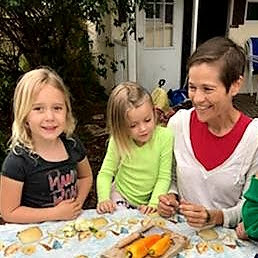
Recently, we had a puppet play about a little beaver. He is looking for a place to start his own lodge and the children learn through the puppet play, how beavers do this. They also learn the habits of the beaver as he builds his lodge. Chewing through the trees dragging them to the river and eventually making a pond. We had many stories, some using picture books and some orally with no pictures to look at. We have also used beeswax to make different things, from the stories. Modeling beeswax is handed out to the children before the story. The story is told and they can warm it, by holding it in their hands and model it into something from the story or something else that they want. This helps to hone their listening and fine motor skills.
An important part of the curriculum is Forest Fridays. We have gone to Crowley Nature Preserve, Oscar Scherer Park, Phillipi Creek Park and Red Bug Slough. At the parks we hike and spend time out in nature. This helps the children reconnect with the natural world and observe how the birds and animals behave. Their observation skills are heightened and they are allowed supervised freedom to explore. This past Friday at Red Bug Slough, we had a visit from “Birdman”, (Christopher Akbar Miller). He came and spoke to us about birds in the area. Which ones were endangered, observing them and identification of feathers. The children loved it and learned alot about birds. Thank you! Ms. Jessica and Mr. Jon also facilitated a game called Hawk and Bird. Thank you, Mr. Jon and Ms. Jessica.
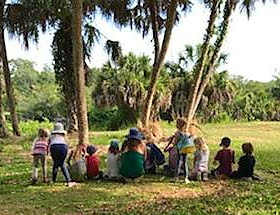
The Early Childhood has so many opportunities for children to grow, learn and start to explore who they are. It is just a matter of seeing the opportunities and engaging with them. We would also like to thank, Amy Rodriquez, Kalin Wilson, Ms. Brittany, and Miriam Cornell, for their kind help and donations.
~Ms Laura and Ms Birte
1/2nd Grade
The first grade began their arithmetic block by hearing a story about four gnomes who all have a job to do at the mine, either under ground or in the store, selling gems. Polly Plus, Mindy Minus, Desmond Divide and Milton Multiply found themselves with a lot of adding, subtracting, multiplying and dividing that needing doing, and great adventures trying to work together for answers to problems that would arise each day! The children also worked individually, as which ever gnome I placed on their desk, and a basket of gems, to figure out arithmetic “problems” I presented.
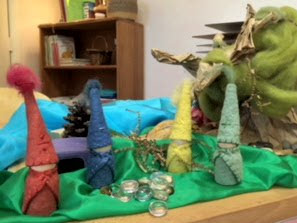
We then began counting, first just simple counting to 50, then 100, reciting together as a class. We had number hunts around the room looking for the next number in line to put in the number line on the board. We walking around campus, counting the steps to our favorite places and especially had fun guessing what the number might be ahead of time. We then moved into skip counting. To begin, we clapped every other number, or hopped every third letter, or invented silly reminders to help us with the number of the day. These rhythms make counting a more integrated learning experience, and the children love the challenge of knowing the patterns. The children then drew number lines in their books, skipping along to each number. Most recently we have begun saying some numbers quietly and only the main numbers aloud, thus 2,4,6,8….., often while clapping or throwing bean bags to continue the rhythm. The first graders did a short form drawing block, but instead of individual forms, there were several forms, all combining to tell a story. This was lots of fun for them, to “read” a story, with no words!
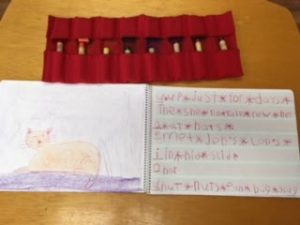
The second graders arithmetic block focused on number place value. First with a simple representative drawing, then lots of different games and activities to work our way from tens, to billions. So much fun to try to figure out huge numbers!
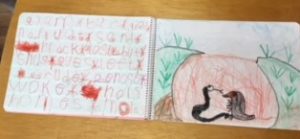
We then returned to language arts, reading and their first spelling tests. The words were all from books we read, and written, several times, then the children write the word as I recite it. They then correct their own and enjoy seeing how they did. Writing practice continues through these tests as well as form drawing. We mostly have concentrated on horizontal repetitive drawing to help with future cursive writing. The children also did some mirror drawings, above and below a line, as well as left and right side of a line. They found many of these to be very challenging! We are now working with name, doing, how and picture words, as an introduction to parts of speech. We began with a story, with many clear examples, and are now writing short sentences that contain name and doing words such as: I stand. We knit. The wolf runs.
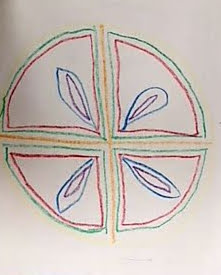
The second graders are more and more enjoying “real” work, and are excited when I tell them I have something “really hard” for them to try!
~Ms McMillan
3/4th Grade
Our studies this spring have been abundant and expansive, ranging from the twilight of the Aesir to growing our understanding of the resurgence of the Puma concolor coryi.
Our second Math block consisted of exploring the four operations in the world of fractions. Confusion was a companion we learned to befriend during this block, as we journeyed through adding and subtracting fractions with like denominators, multiplying, reducing fractions, creating and utilizing the tool of factor candelabras, simplifying, cross simplifying, dividing fractions, and expanding fractions when adding and subtracting those with unlike denominators. The children created what resembles a fractions “textbook” in their main lesson book, and used graphing notebooks to practice numerous problems. Those who were ready for greater challenges completed problems of increasing complexity. Simultaneously, children maintained the practice of making their knowledge of multiplication facts increasingly automatic through group challenges and card games. Food, manipulatives, and consistently thinking about the problems in terms of pizza or pie (to ensure that nobody got more than anyone else) were ways we deepened our understanding of the fractional abstractness we encountered.

As spring proceeded, we set out on the journeys of Thor and his curious relationships with the Giants of Jotenheim, the service of the Valkyries, the tales of the warriors of Valhalla, the story of Idun’s capture and return, Loki’s role in the death of Baldur and finally Ragnarok. It is a chaotic and destructive twilight of the Aesir, which was both subtly startling and captivating for the children. Many verbalized their recognition that many characteristics of various gods in fact were alive within themselves. Odin said to his fellow Aesir before the battle with the fire-giants of Muspelheim, Loki, the Fenris Wolf, the Midgard Serpent, and the giants of Jotenheim, “If we fight with all our strength and courage, then even if we are destroyed, the powers of evil will be destroyed also.” It was a fire set by Surt that transformed the world physically and metaphysically. After some time of darkness, the light of a new dawn returned. And with this light, new life.
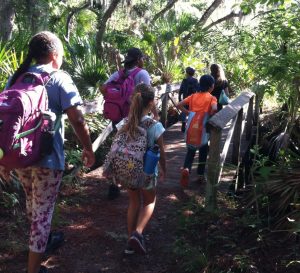
And with this new light, we journeyed back to our present lives, to Homosassa Springs Wildlife State Park. We were immediately granted the privilege of witnessing a successful owl hunting expedition as we rode the tram through the park. Many manatees, including Ariel, Electra, Lorelei, and Betsy among others were present as we approached the fresh spring. Schools of fish were seen from the underwater observatory, and along the river turtles, birds of great variety, canines, deer and more. We were so fortunate to spend time with Jayne Johnston, a panther outreach specialist of the Florida Fish and Wildlife Conservation Commission. Jayne shared a great deal of FWC’s research on the Florida Panther. Students from Mangrove School were among those who asked questions during the presentation. After attendees left, the children spent another 15 minutes with Jayne dialoguing about panthers. Jayne was nonetheless impressed with our children, and encouraged them to stay in touch with her as we learn about panthers. Many thanks to Tiffany Blackden for driving, and Heather Green for her generous support!
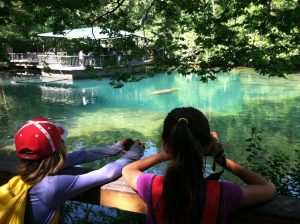
After this exciting start to our second Zoology block, we spent time learning about manatees. Children continued creating their on compositions after lessons, receiving revision and editorial feedback, and then writing in their main lesson books. We are looking forward to attending a presentation on manatees offered by the UF/IFAS Extension Sarasota County on the 23rd of May. After our time with Jayne learning about panthers, the children have a great appreciation and thirst for learning first hand information from inspiring scientists. In the classroom, extra care is being taken to draw a manatee and panther in our main lesson books, as accurately sketching the forms of the animals along with an eye for proportion are our current undertakings.
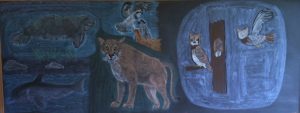
The class unanimously decided to adopt Ariel, a manatee living in Homosassa Springs Wildlife State Park. Save the Manatee Club has many manatees who would appreciate your support if you wish to adopt one! The children have also decided to support a program that raises awareness of Florida Panther and vehicle collisions. In places not too far from Sarasota, there are nighttime panther speed zones that help our state’s panthers. If you wish to learn more about manatees or Florida’s state mammal, the Florida Panther, ask a 3rd-4th grader. We are excited to talk about what we are learning. As our new scientist friends tell us, educating the public is the key to protecting these incredible animals who have just as much right to happiness as all humans!

5/6th Grade
This Spring, much of our time together has been devoted to our study of Medieval times. When we last left off, the Roman Empire, once a robust and mighty coherent mass, had been overcome, and wild Germanic tribes had taken over. Rich descriptions and stories were offered to the children, so they could grasp this stark contrast. The lavish lifestyle of the Romans vanished, and a long with it, much of the knowledge of humankind. The earth had become dark, so we naturally went in search of illumination.
In this grade we offer the first part of the Middle Ages, the extreme polarity of Rome. We learned of the rise of the castle and monasteries, the two poles between which European life vacillated between in those times. We received vivid descriptions of the lives of valiant knights, and the focused monks, then practiced their ways of life. In our books we printed carefully in Carolingian script, the primary script of the early middle ages, just as the monks once did. They created their own Coat of Arms, originally used as a way for knights to distinguish one another, thus expressing their budding individuality. We saw a familiar concept in feudalism, the feudal manor, and why that arose; so many said, “Wow, that is just like the caste system we learned about last year!” (So very insightful considering the evolution of consciousness throughout last year, finally arriving in Greece, whereas now we are laying the foundation for the Renaissance). We learned of the rise of France, Clovis, and his conversion to Christianity, and the last impact of this on Europe. We heard of Muhammed and the rise of Islam in the land between two rivers (Also familiar from last year…Mesopotamia, another evolution). We learned about the Muslim religion, and the challenge of a rapidly rising monotheistic religion in a formally polytheistic tribal culture. We learned about the consolidated power of Christianity and the exile of philosophy, mathematics and astronomy, and the subsequent great movement east of the remaining Greek philosophy and culture, finding the majority of great texts, knowledge, and healing were mostly in Islamic lands. We learned of the gifts that this consolidation has brought us…beginning with…arabic numbers! Only in the monasteries in Europe did they hold to whatever they could; Europe otherwise laid in a dormant state…how can this be good? We shall see…
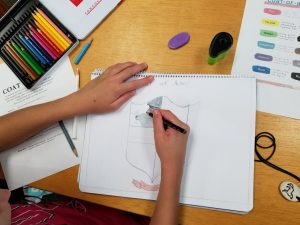
From this block, and continuing through the end of the year, the students have embarked on a project to become modern-day knights, as we learned that in order to become a Medieval knight one had to commit to many virtues, including to always be courteous and truthful and to lead a brave and honorable life. At this time in their life, it is appropriate that they begin to think about who they are as an individual in the world and to begin to think about what kind of person they wish to be when they are older. We talked about the importance of chivalry, in modern times as well, and the positive impact one can have on those around them, by focusing on various virtues.
In the Middle ages, during his training, a page was taught the lessons of etiquette, to care for his belongings, and to be helpful and courteous to all. They worked hard to develop the skills needed to succeed in his given tasks, which included strengthening both mind and body. In doing this, he became ready to serve the world with fortitude, determination and honor.
This was our task towards the end of the year. Those who carried out these tasks in a manner worthy of knighthood will receive a final challenge, which when accomplished will result in an individual knighting ceremony. Part of our training included a group community service project in which they planned and executed an initiative to benefit a charitable organization in the Sarasota area, which was Satchel’s Last Resort Animal shelter. (They are still taking donations in the office.)
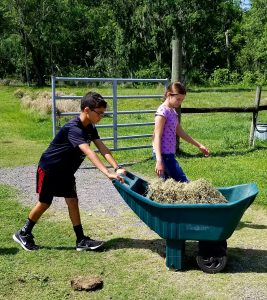
In addition to etiquette classes, and increased mindfulness, each student selected and interviewed an adult they admire who possesses the personal qualities that they hope to cultivate in themselves. They each chose aspect of their lives that they would like to improve, and worked over the semester to improve in this area or areas.They participated in several service periods on campus, including Community Lunch, Courtyard clean up, and random acts of kindness. In addition, they built a new swing set in the playground for the younger students, with the expert assistance of Mr Eric and Bryan Suter. They worked on a program to strengthen their bodies. We also engaged in a few physical challenges or skills along the way pertaining directly to knighthood or the qualities one must strive for to be a knight, such as bravery and courage. They completed their horsemanship block for this year, which went way beyond basic horse safety, grooming, maintenance and riding. our students learned how to recognize and address the horse’s emotions, and how to treat these magnificent beings with the utmost respect, dignity and reverence! Such incredible connections were made between these developing preteens and these gentle souls. They learned qigong, and how to move powerfully with grace. They faced big fears by climbing an adventure tower, with each student meeting their own personal goal, and some demonstrating they had remarkable cat-like prowess in this area! Modern day Knighthood now lies before them, with one more challenge to overcome!
We also spent some focused time in language arts, reviewing different types of letters, subject pronouns and object pronouns, and expository versus narrative writing, giving them two very different ways to view the world, and common grammatical errors. We added an additional art class, in order to split the class for ukulele, and to introduce additional mediums such as pastels and clay.
We finally were able to visit the planetarium and were treated to among other things, a show exclusively about our current night sky. Just as we have learned up to this point, all observations made with our eyes. The students were able to see which planets are visible right now, and which ones aren’t, and why not, as well as a few constellations we had spoken about in class. The revealed in this interactive experience,with a gregarious astronomer, answering many questions during this interactive experience, about astronomy as well as history, from Greece to Rome. They were impressive students, as king thoughtful questions as well..
Physics is our last block of the school year, and for good reason: it is very hands on and accessible to all, as we can make connections to many aspects of their lives. Science is all around us, not just in a laboratory. At this age, we cover the basic properties of light, sound, heat, magnetism and electricity, and through our various experiments, students utilize their new capacities of thinking. They experience phenomena through demonstrations and activities, then at our next meeting, we will review, allowing them time to digest their observations, and then draw conclusions and arrive at the concepts that each activity or demonstration is bringing them. This conceptualizing only occurs if students analyze and make conclusion from their experience. The final part of this is the write up. This can be in many forms, such as, a lab report, an expository summary of what happened, and even a poem. This aspect of physics engages their will forces; it isn’t just about them taking in, they are also digesting this and then creating something from it, both a written summary as well as an illustration. This is a very engaging block as they try out various everyday materials in ways they haven’t before, such as the sound of a spoon hitting the desk through the air versus through a different media, or manipulating light sources to create different shadows,which of course we then drew, as we want to bring art into science, unifying these subjects for them.
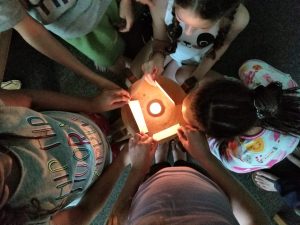
The goal of Physics is to give us an understanding, appreciation and acceptance for the world human beings have created. Modern technology surrounds us, yet most don’t understand the basic principles governing these processes. The founder of Waldorf education warned of this, as the beginning of “unsocial life”, the acception the inventions of modern man, without understanding them. In our times, this seems a very crucial aspect of our lives to grasp, rather than a mindless utlization. As the students are geting older and beginning to use more technology, as they begin to have a basic understanding of these creations, they can feel at home in this world and approach them with confidence and mindfulness.
For their dedication to their knight training, the students embarked upon a trip to the springs; a time to unplug and simply enjoy the nature around them, while also maintaining camp, and helping each other. Such a beautiful time!
~Ms Erin

